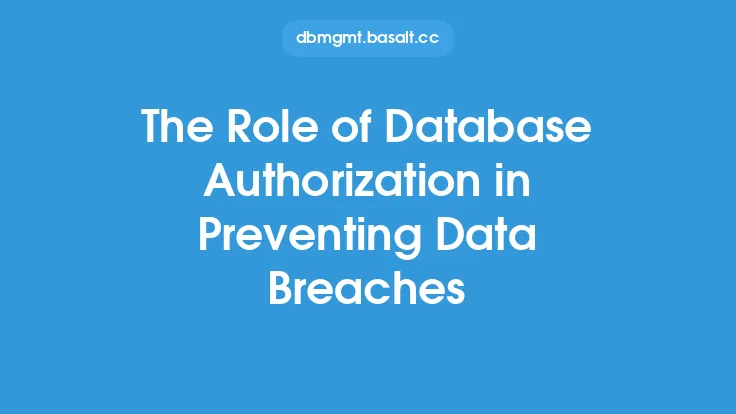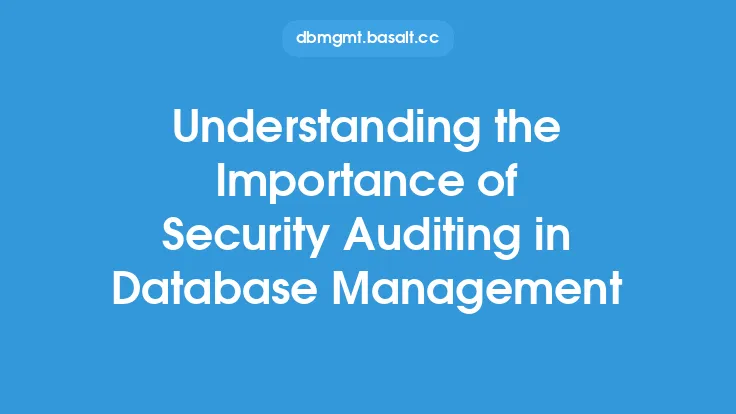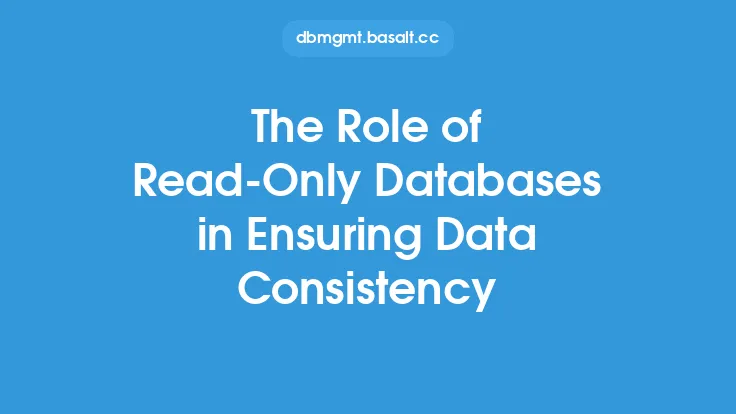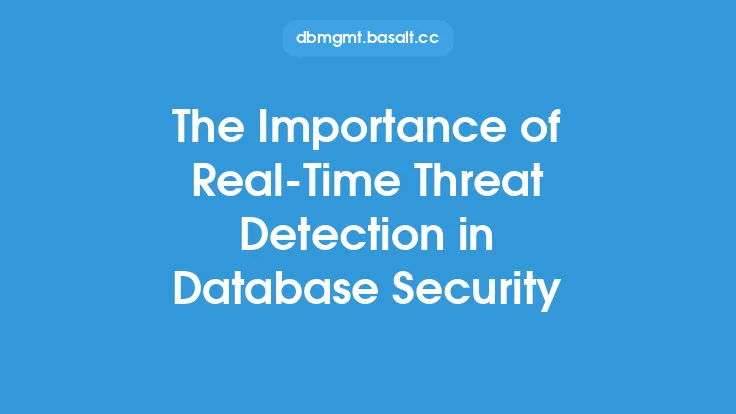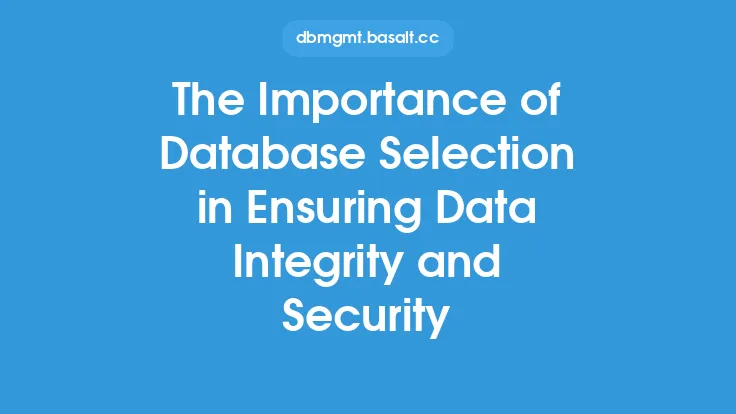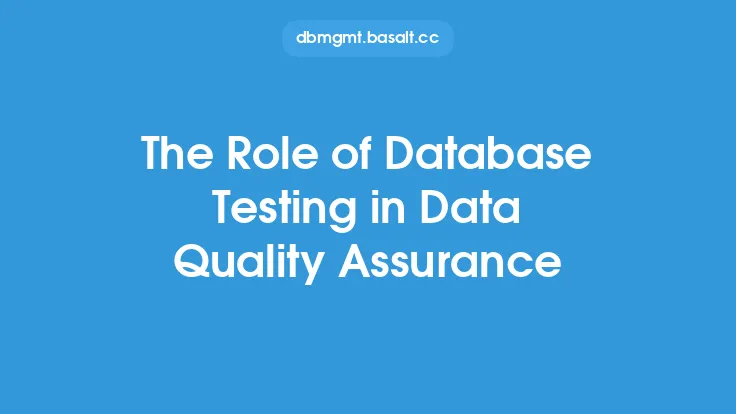Database security is a critical aspect of protecting sensitive data, and one of the key components of database security is authorization. Authorization is the process of determining what actions a user can perform on a database, and it is essential to ensure that only authorized users have access to sensitive data. One of the most effective ways to implement authorization is through role-based database authorization. In this approach, users are assigned roles, and each role is associated with a set of privileges that define what actions the user can perform on the database.
What is Role-Based Database Authorization?
Role-based database authorization is a security approach that assigns users to roles, and each role is associated with a set of privileges that define what actions the user can perform on the database. This approach is based on the principle of least privilege, which states that users should only have the privileges necessary to perform their jobs. Role-based authorization is a flexible and scalable approach that allows administrators to easily manage user access to the database. It is particularly useful in large organizations where there are many users with different levels of access to the database.
Benefits of Role-Based Database Authorization
There are several benefits to using role-based database authorization. One of the main benefits is that it simplifies the process of managing user access to the database. With role-based authorization, administrators can easily assign users to roles and manage their privileges without having to individually configure each user's access. This approach also reduces the risk of privilege creep, which occurs when users accumulate privileges over time that they no longer need. Role-based authorization also improves auditability, as it provides a clear and transparent way to track user access to the database.
How Role-Based Database Authorization Works
Role-based database authorization works by assigning users to roles, and each role is associated with a set of privileges that define what actions the user can perform on the database. The process of implementing role-based authorization typically involves the following steps:
- Define the roles: The first step is to define the roles that will be used in the database. This typically involves identifying the different types of users who will be accessing the database and the actions they need to perform.
- Assign privileges: Once the roles have been defined, the next step is to assign privileges to each role. This involves determining what actions each role should be able to perform on the database.
- Assign users to roles: The final step is to assign users to roles. This involves mapping each user to the role that corresponds to their job function.
- Manage role hierarchies: In some cases, roles may be organized in a hierarchy, with more senior roles inheriting the privileges of more junior roles. Managing role hierarchies is an important aspect of role-based authorization.
Technical Implementation of Role-Based Database Authorization
The technical implementation of role-based database authorization typically involves creating roles and assigning privileges to each role using SQL commands. For example, in Oracle Database, roles are created using the CREATE ROLE command, and privileges are assigned to roles using the GRANT command. In MySQL, roles are created using the CREATE ROLE command, and privileges are assigned to roles using the GRANT command.
In addition to creating roles and assigning privileges, the technical implementation of role-based authorization also involves managing user access to the database. This typically involves creating users and assigning them to roles using SQL commands. For example, in Oracle Database, users are created using the CREATE USER command, and they are assigned to roles using the GRANT command.
Best Practices for Implementing Role-Based Database Authorization
There are several best practices for implementing role-based database authorization. One of the main best practices is to keep the number of roles to a minimum. This makes it easier to manage user access to the database and reduces the risk of privilege creep. Another best practice is to use descriptive role names that clearly indicate the purpose of each role. This makes it easier to understand the privileges associated with each role and reduces the risk of errors.
It is also important to regularly review and update role definitions to ensure that they remain relevant and effective. This involves monitoring user access to the database and updating role definitions as needed to reflect changes in user job functions or business requirements.
Common Challenges and Limitations of Role-Based Database Authorization
While role-based database authorization is a powerful approach to managing user access to the database, there are several common challenges and limitations to be aware of. One of the main challenges is that role-based authorization can be complex to implement, particularly in large organizations with many users and roles. Another challenge is that role-based authorization may not be suitable for all types of databases or applications.
In some cases, role-based authorization may not provide sufficient granularity, particularly in cases where users need to perform specific actions on specific data. In these cases, more fine-grained approaches to authorization may be needed, such as attribute-based access control or mandatory access control.
It is also important to note that role-based authorization is not a replacement for other security measures, such as authentication and encryption. A comprehensive database security strategy should include multiple layers of protection to ensure the confidentiality, integrity, and availability of sensitive data.
Conclusion
In conclusion, role-based database authorization is a powerful approach to managing user access to the database. By assigning users to roles and associating each role with a set of privileges, administrators can simplify the process of managing user access and reduce the risk of privilege creep. While there are several benefits to using role-based authorization, there are also several common challenges and limitations to be aware of. By understanding the technical implementation of role-based authorization and following best practices for implementation, administrators can ensure that their databases are secure and compliant with regulatory requirements.
